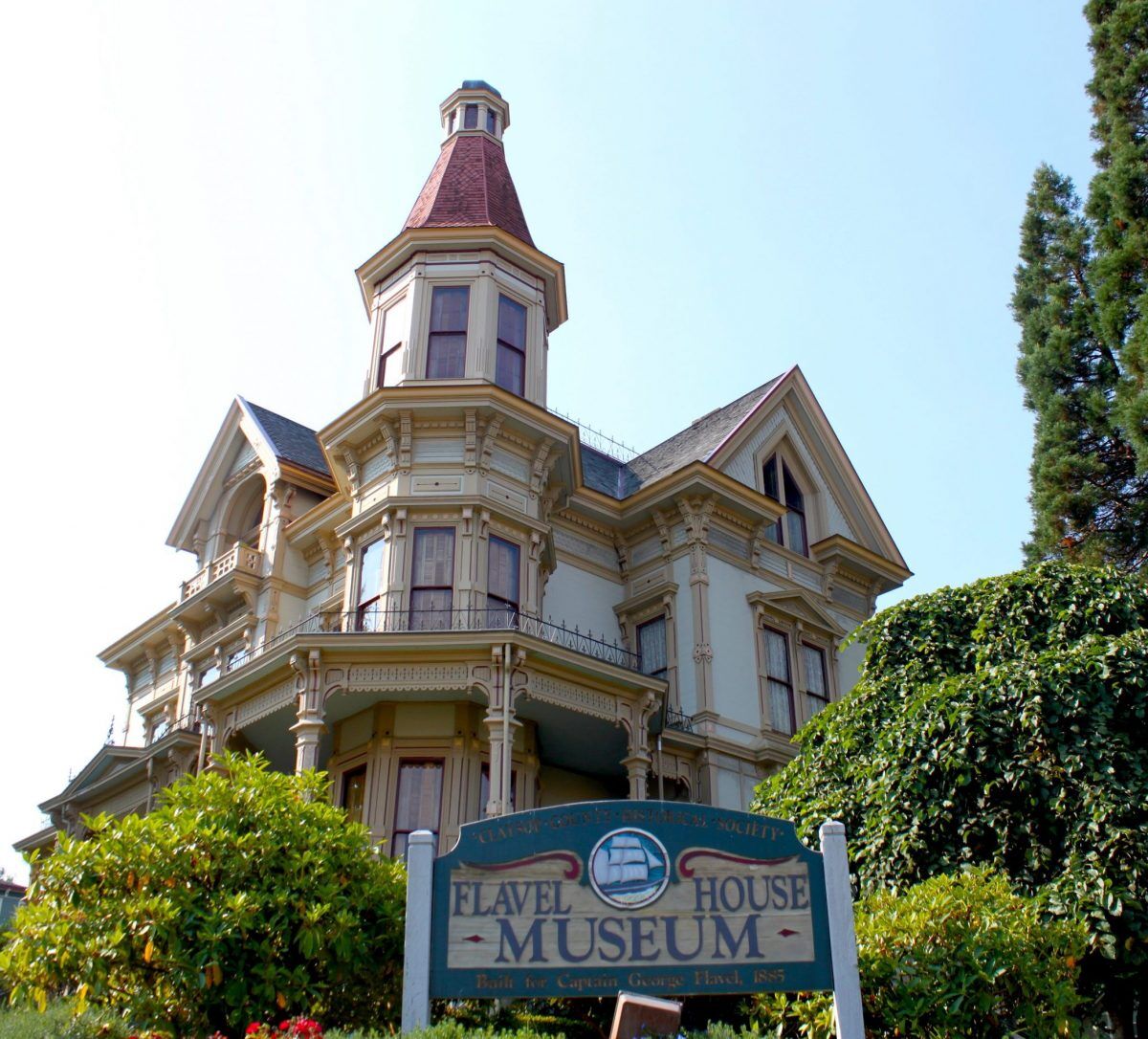About the House
The Flavel House in Astoria, while now a museum, was once a mansion that is haunted by the spirits of those poor souls of the family who once inhabited its walls. The phantom remnants of the Flavel family have made themselves known by speaking amongst themselves—which has been reported as disembodied voices—as well as practicing music in the empty rooms. A woman’s ghost has been sighted in the hallway, and Captain Flavel himself has been seen in his old bedroom before promptly vanishing.
The Interior
A Queen Anne style, two and a half story, 11,600 square-foot behemoth, the Flavel House sits on the corner of a fairly large plot of land—there is traditional woodwork around the interior windows, doors, windows, and staircase, all of which are Eastlake-influenced in design. The doors and window trim were made of Douglas Fir and were crafted by a master carpenter to look like mahogany and burl rosewood. There are six unique fireplace mantels within the house and they feature different imported tiles from around the world, an elaborate hand-carved mantel and a patterned firebox designed to burn coal. The first floor features fourteen-foot high ceilings, where the second floor’s ceilings sit at twelve feet high and are both embellished with crown molding and plaster medallions. The house was also fitted with indoor plumbing—incredibly state-of-the-art at the time—as well as gas-fueled lighting.
The first floor is dedicated to the public rooms, such as the grand entrance hall, formal parlor, music room—where the Flavel daughters held their music recitals—the library, dining room, and conservatory. The more private rooms on the first floor included the butler’s pantry, kitchen, and mudroom which were reserved for the housekeeping staff. The second floor was where the main bathroom, five bedrooms, and a small storage room or sewing room were. The attic floor is large and unfinished and houses the two plain wood bedrooms that were used by the Flavel’s domestic help. The four-story tower was made for the Captain to have a 360-degree view of Astoria and the Columbia River as a way for him to keep an eye on the local ship traffic coming through. There was also a dirt-floor basement that housed the large wood-burning furnace that kept the house warm.
The Carriage House was home to the family’s caretaker, and was also originally made to hold the family kept their carriage, sleigh, and small buggies—where it had three temporary holding stalls for their horses, a tack room, and an upstairs hayloft. In time it was transitioned to hold the more modern vehicles, such as the Flavel’s Studebaker sedan, and the family’s driver kept a room upstairs.
The Grounds
Not too long after the house was originally built, the family’s gardener, Louis Schultz, began planting trees, beautiful roses, as well as bulb flowers and shrubs—many of which were typical of a traditional Victorian garden. A number of the trees on the premises were officially named Oregon Heritage Trees—there is also a pond and a bench under the pear tree where Flavel’s daughters would sit in the shade. The entire house is considered a significant architectural and historical treasure for the entire Pacific Northwest.
The Timeline of the Flavels, Their Houses & Fate
1886
While the construction of the Captain George Conrad Flavel house was started in 1884, and it was finally finished in the spring of 1886. The Flavel House was built for Captain George Conrad Flavel and his family. The house was designed by German-born architect Carl W. Leick and the construction bordered between the Victorian and Colonial Revival periods. It was considered a prime example of Queen Anne architecture; one of the few remaining well-preserved examples in the entire Northwest. Due to the Captain’s long history and contributions to the community of Astoria, the Flavel family had long been considered the most prominent family in town.
The Captain had made his name and fortune as a prominent businessman through real estate investments and his occupation as a Columbia River bar pilot—becoming Astoria’s first millionaire—at the age of 62, he was finally able to retire in the house that he had built for himself and his family.
1887
The Carriage House was built on the south-west corner of the property.
1890s
Alex Murray, the family’s hired caretaker, called the Carriage House home while in the employment of the Flavels.
1893
Captain Flavel lived in the house for seven years with his wife Mary Christina Boelling and their two adult daughters, Nelli and Katie. Their son, George Conrad Flavel never resided within the George Conrad Flavel House, as he was already married and living in a house of his own. During his seventh year in the residence of the Flavel House, Captain Flavel passed away, leaving the to the family.
1901
Captain George Conrad Flavel’s son, George Conrad Flavel would build his house—the house that is now often referred to as the Harry Flavel House. George Conrad Flavel Junior had worked as a bar pilot for his father, becoming a Captain as well.
1922
When most of downtown Astoria was destroyed by a fire, the Flavel House was one of the only survivors.
1934
The Captain George Conrad Flavel House remained in the family until the great-granddaughter Patricia Jean Flavel gave the property to the city as a memorial to her family.
1936
The house was set to be torn down to establish an outdoor community property—the city ended up having financial difficulties and returned the property to Patricia Flavel—that same year, Patricia deeded the residence to Clatsop County, but with conditions. The understanding was that both the grounds and the house would be kept in good repair and used for public purposes.
1937
From the time the house was deeded the to county, until the end of World War II, the Public Health Department, Red Cross, and local Welfare Commission all had offices within the mansion.
1951
The Captain George Conrad Flavel House was officially added to the list of the National Register of Historic places, before which it was nearly demolished twice—once for a parking lot and again for a community park, but the townspeople rallied against the proposal and it began to be operated by the Clatsop County Historical Society in 1950.
2003
The Camperdown Elm, Sequoia Redwood, four Cork Elms, Bay Laurel, Pear, and Ginkgo Biloba trees on the premises were named official Oregon Heritage Trees in a state-wide dedication ceremony that was held on the grounds.
The Haunting at Captain George Conrad Flavels House
Truly, ever since the Flavel house was converted into a museum in 1951, there have been many reports of hauntings; phantom music and voices were heard on the first story of the house which was believed to have been a product of the Flavel sisters, as they were gifted musicians. The Library has always housed an unhappy and strange presence. There is an apparition of a woman who roams the hallway on the second floor, but she vanishes when approached—and a floral scent can be smelt at strange times in the bedroom of Ms. Flavel, when no one has been around. In Captain George Flavel’s room, his apparition can be seen, but he disappears into the floor once he has been noticed.

Georgia-based author and artist, Mary has been a horror aficionado since the mid-2000s. Originally a hobby artist and writer, she found her niche in the horror industry in late 2019 and hasn’t looked back since. Mary’s evolution into a horror expert allowed her to express herself truly for the first time in her life. Now, she prides herself on indulging in the stuff of nightmares.
Mary also moonlights as a content creator across multiple social media platforms—breaking down horror tropes on YouTube, as well as playing horror games and broadcasting live digital art sessions on Twitch.


